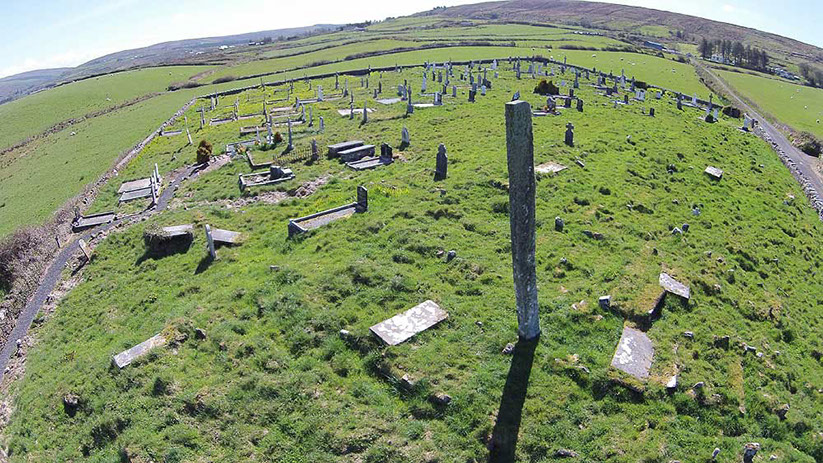Doonfeeny Standing Stone & Church
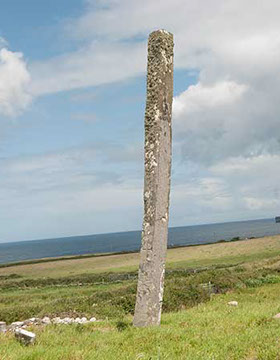
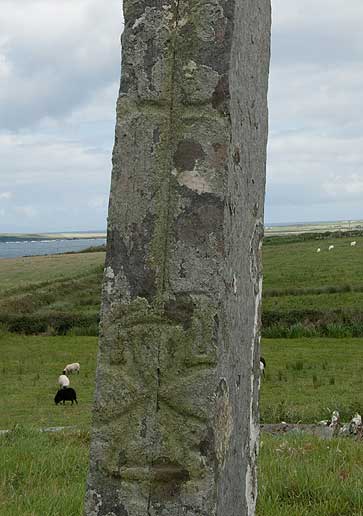
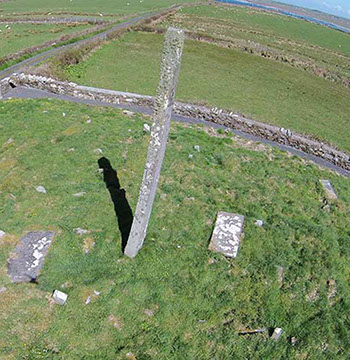
Also known as a Menhir or Cloch Fada-‘Long Stone,’ this “Standing Stone” is situated about 3.2 kilometres NW of Ballycastle, in an ancient graveyard close by the old church of Doonfeeny.
Of pagan origin and reputed to be the tallest of all the Irish “Standing Stones,” this impressive square-sectioned, leaning pillar which stands over 4.5 metres high is an excellent example of a pre-Christian monument. The stone has been Christianized by two crosses, a single-line Latin cross with forked ends and horizontal base placed over a double-line Maltese type cross with a curved ‘bird’s head design’ line; it was probably carved about the sixth/seventh century. The pillar also boasts time-worn signs of earlier ogham inscriptions.
The Ordnance Survey letters (1838) describe the stone in the following manner:- “ A stone 18’ or 20’high and 9” thick, fixed in the ground and inkling to the East, on the N.W. side of which is cut the form of a cross about 2’ long, with a small cross 10” long and some ornamental incisions under it.”
There once existed a tradition in parts of the west of Ireland that some of these standing stones were used as ‘Fertility Stones’ by women seeking to get pregnant, or alternatively, as a primitive form of contraception, and it is recounted that women were known to prostrate themselves before these stones all the while praying that ‘they might be delivered from the perils of childbirth.’
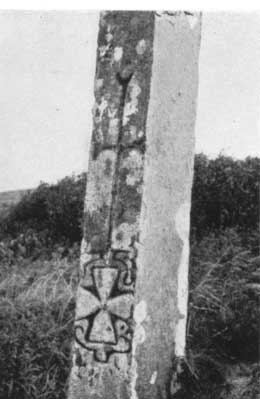 It is maintained that the superstitions of a people will often throw a light upon their ancient faiths. The eclectic scholar, the Rev Baring-Gould (1834-1924) once remarked, “Much of the religion of the lower orders, which we regard as essentially divine, is ancient heathenism, refined with Christian symbols.” Whatever doubts we may have in relation to this, most people admit the underlying paganism of some customs, credences, or sayings and that the local fetishism to be found in Ireland simply represents the undying faith of the older race.”
It is maintained that the superstitions of a people will often throw a light upon their ancient faiths. The eclectic scholar, the Rev Baring-Gould (1834-1924) once remarked, “Much of the religion of the lower orders, which we regard as essentially divine, is ancient heathenism, refined with Christian symbols.” Whatever doubts we may have in relation to this, most people admit the underlying paganism of some customs, credences, or sayings and that the local fetishism to be found in Ireland simply represents the undying faith of the older race.”
The nineteenth- century biblical scholar, Dr James Henthorn Todd, in his work on Irish Religion, ventured on more tender ground, when he wrote concerning the “Guardsman’s Cry” of St. Patrick—“The prayer which it contains against women, smiths, and Druids, together with the invocation of the powers of the sky, the sun, fire, lightning, &c., proves that, notwithstanding the undoubted piety and fervent Christian faith of the author, he had not yet fully shaken off the pagan prejudices.”
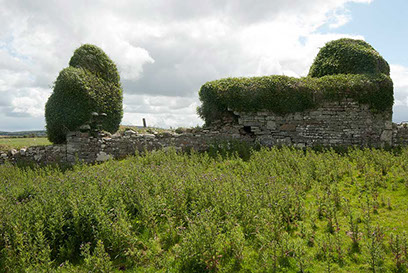 The ancient church ruins now visible in Doonfeeny Churchyard are not those of the original Patrician church but one built on the same site at a later date (possibly seventh century). The aforementioned Ordnance Survey Letters inform us that immediately to the South of the church is a graveyard “surrounded with a claidh (foss) in the form of a fort (lios) as may be concluded from the circumstance of the South-West part of it being still observable, the part to the North being removed to give way to a road.” This may be the Dún (fort) which gives its name to the parish.
The ancient church ruins now visible in Doonfeeny Churchyard are not those of the original Patrician church but one built on the same site at a later date (possibly seventh century). The aforementioned Ordnance Survey Letters inform us that immediately to the South of the church is a graveyard “surrounded with a claidh (foss) in the form of a fort (lios) as may be concluded from the circumstance of the South-West part of it being still observable, the part to the North being removed to give way to a road.” This may be the Dún (fort) which gives its name to the parish.
Moreover, in 1912 the church is described as having “fine cyclopean masonry in the north wall and the remains of a pointed east window, the jambs adorned by a bold roll moulding. Unfortunately, the south jamb and gable collapsed. The eastern part of each side is levelled, the southern before 1817, when the tomb of the May family of Ballycastle was made upon it. The south door is lintelled, and the two irregular ambry-like opes are in the west gable. the building is 41 feet long and 20 feet six inches thick...The custom prevails here, as in the Mullet and elsewhere, of leaving the tobacco-pipes used at the wakes upon the graves, it is unlucky to remove them.”
 There is a tombstone in the old church which bears the date 1671-something of a rarity in any Irish country churchyard, especially a Catholic one.
There is a tombstone in the old church which bears the date 1671-something of a rarity in any Irish country churchyard, especially a Catholic one.
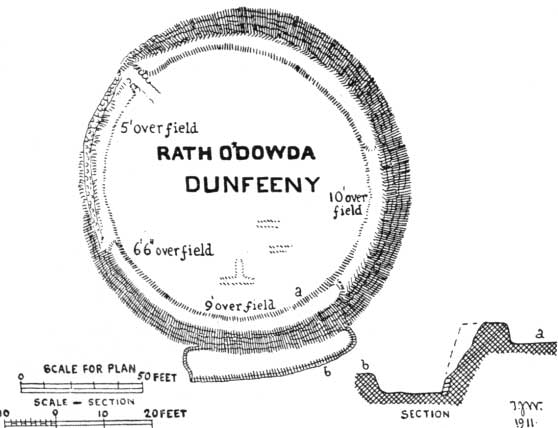 On a hillside, about half a kilometre N.W. of the church is an earthenwork known today as ‘The fairy Fort of Dunfeeny’-in reality Rath Ui Dubhda –‘ O’Dowd’s Fort.’ Nearby two Holy Wells were located which were attributed to St. Derbile (Derval) and St. Brendan, specific Stations were once performed here. In 1417 this area was called ‘Dun Fine of the Apple Trees, the habitation of High hosts,’ or ‘Dun Fine of the Host of Lances,’ and it is traditionally told that the infamous murderers, the Four Maols, whose grave is marked by a dolmen in Ballina town, ‘dug’ a fort here in the sixth century which they dedicated by ‘killing swine’ a Pagan influenced “Christian” substitute for human sacrifice.
On a hillside, about half a kilometre N.W. of the church is an earthenwork known today as ‘The fairy Fort of Dunfeeny’-in reality Rath Ui Dubhda –‘ O’Dowd’s Fort.’ Nearby two Holy Wells were located which were attributed to St. Derbile (Derval) and St. Brendan, specific Stations were once performed here. In 1417 this area was called ‘Dun Fine of the Apple Trees, the habitation of High hosts,’ or ‘Dun Fine of the Host of Lances,’ and it is traditionally told that the infamous murderers, the Four Maols, whose grave is marked by a dolmen in Ballina town, ‘dug’ a fort here in the sixth century which they dedicated by ‘killing swine’ a Pagan influenced “Christian” substitute for human sacrifice.
View these photos in a gallery
